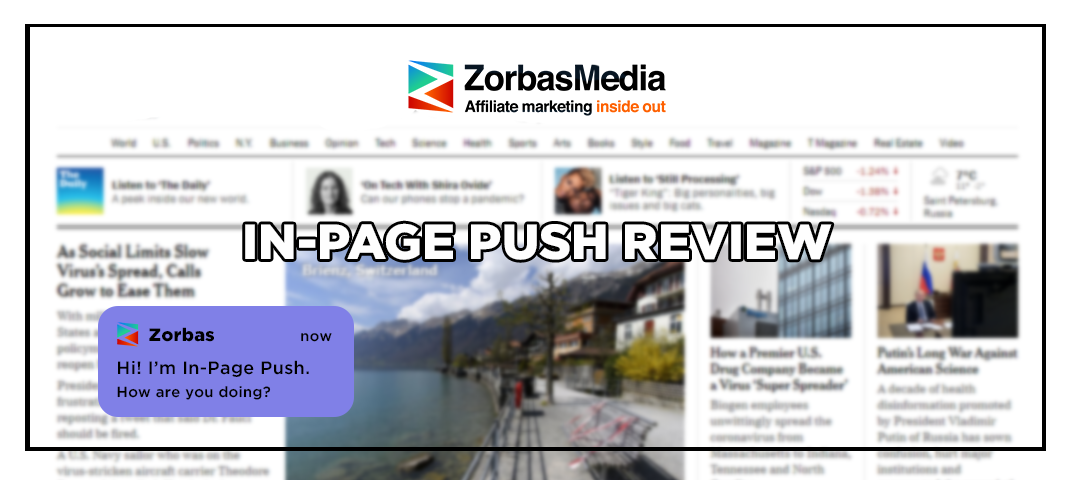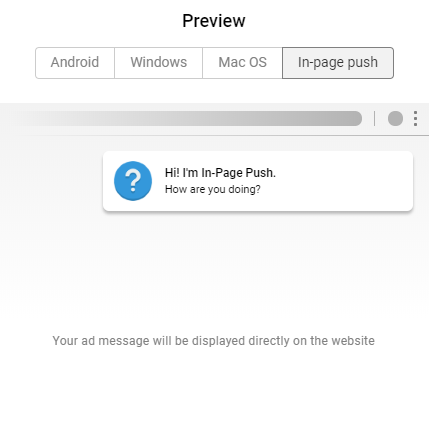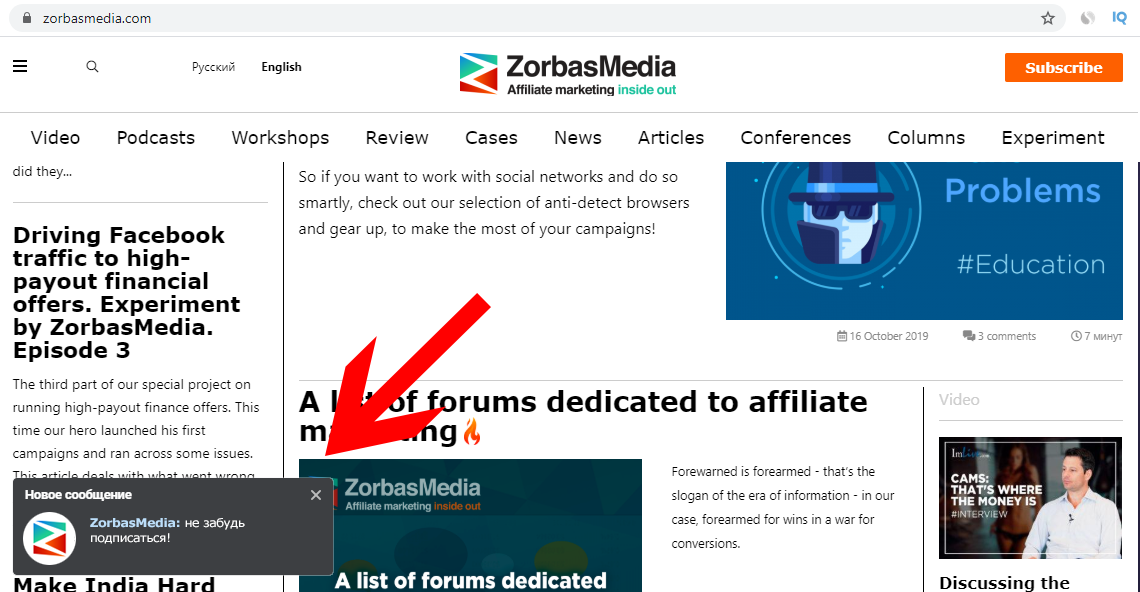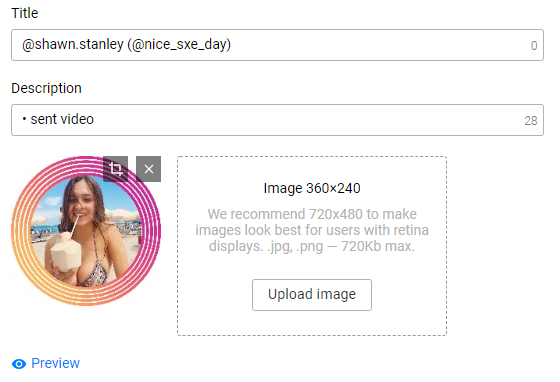
Hi there! Today, we are breaking down In-Page Push, a brand new type of traffic added to the ad network PropellerAds inventory. At the end of the article, you will find a case study comparing the effectiveness of In-Page Push versus conventional push ads by driving this kind of traffic to dating offers provided by our partners at ClickDealer.
What is In-Page Push designed for?
Push traffic has been declared dead multiple times since it was first introduced. Both Google Chrome users and developers were annoyed at how push notification databases were grown. Little did Google suspect that its push alert system designed to bring value would turn into a virtual billboard. There seems to be a precedent for that though, i.e. in-app push notifications on Android. Efforts taken to remedy the situation such as flags and various sanctions imposed by Chromium forced ad networks to develop new ad formats and additional revenue sources should traffic volumes decline. Obviously, you can’t eradicate ads on push notifications completely. What Chrome developers can do is to hamper the growth of push subscriber bases (which will lead to a decrease in market volumes). The In-Page Push format (IPP) was developed by PropellerAds last December as a response to this threat.
What is In-Page Push?
In-Page Push is a banner that looks like a traditional push notification and is shown on the user’s device (be it a PC, tablet, or smartphone):

The idea behind this is not new at all: once some popular social networks rolled out push notifications, websites were quick to introduce banners imitating these alerts.

Overall, in-page push functions more or less similar to traditional push notifications:
- The surprise effect: a banner unexpectedly pops up on the smartphone screen and thereby becomes the focus of attention.
- Once the user clicks on an alert, they get redirected to an offer page.
However, there are considerable differences between these two ad formats. So, let’s break them down.
- There is no large image. This fact has little effect on mobile traffic (large images are almost never displayed on mobile push). However, it does affect desktop traffic considerably, as large images are displayed on most desktop devices.
- The user interacts with an In-Page Push message directly in the browser (on the publisher’s website) rather than on the device. This leads us to two conclusions. First, there’s a 100% chance that the user will see your notification. As far as traditional push alerts are concerned, the ad can get lost among other notifications such as system messages. Second, you won’t get any clicks after n period of time because a notification disappears once the user closes the page/browser.
- Since IPP is a banner, it doesn’t simply disappear from the screen after a while. It will be displayed on the website until the user opts to close it, update the page or go to another one.
- Although an IPP banner looks similar to a traditional push notification, they are not exactly the same, which is likely to attract users’ attention.
Pros and cons of In-Page Push
The key advantages:
- iOS traffic, which is something a lot of push advertisers have been anticipating. iOS devices make up a considerable share of traffic from some lucrative Tier 1 GEOs. This is an opportunity not to be squandered.
- New audiences. An influx of new users who haven’t interacted with push notifications before is likely to boost push ads performance.
- Additional revenue stream on the webmaster side. IPP enables you to monetize both push notification subscribers and other website visitors.
- Banner customization. We will talk about this in more detail later after highlighting everything IPP has to offer and discussing the format’s prospects for publishers.
The main disadvantages:
- Aggressiveness. IPP is easier to remove from the screen, and so the users are much more likely to pass over your ads, especially if they are poor quality.
- Think twice when choosing CPM. Considering that you must pay every time the impression is generated rather than when the ad is delivered (as is the case with traditional push alerts), CPM may be less profitable. Moreover, it will be more difficult to predict whether such campaigns will be effective.
- Banner click at the price of push click. Mobile push and a web page banner are totally different things, and they convert differently, that’s for sure. The prices are likely to be adjusted in the near future based on the auction and IPP traffic will get cheaper.
- No large image, which will pose a huge challenge if you work with desktop traffic. On the flip side, an IPP without a large image looks more like a user message, which can prove to be effective for some verticals.
In-Page Push prospects
This is where the juicy stuff begins. Due to the fact that this format is relatively simple, it allows for implementing new features that were unavailable for conventional push traffic. Here are just a few of them:
- Animated icons to get users hooked.
- In-banner lead forms. This is a great tool for crypto/Forex offers where the primary goal is to get the user’s phone number.
- You can change the color, size, and position of a banner ad. In other words, IPP enables you to test out everything you want.
What are the prospects for this ad format? Overall, IPP is not something revolutionary. It’s more of an old idea adapted to current needs that definitely deserves affiliates’ attention.
Case Study: Dating, UK, In-Page Push
You can’t make a full review of an ad format if you haven’t tried it in practice, which we did by running a test campaign.
- Campaign time period: 24.03.2020-28.03.2020
- Ad network: PropellerAds
- Affiliate network: ClickDealer
- GEO: UK
- Money spent: $222.15
- Money earned: $251.11
- Profit: $28.96
- ROI: 13.04%
We decided to drive traffic to a ClickDealer offer, which is one of the few affiliate networks that showcases a wide range of offers from different verticals and has established itself as a reliable partner.
So, our manager gave us two offers:
- [MOB] MILFDATES /UK SOI
- [MOB] FLIRTHITS /UK SOI
Then, we put all the offers to a split test.
We used typical dating creatives encouraging people to click on your ads and displaying a good-looking girl. Here’s one of our creatives:

We also used pretty standard survey pre-landers with a “looking for a sex partner” box:

The targeting was set up to reach only mobile users. First of all, we wanted to see how In-Page Push would perform on iOS.
Day 1:

Luckily, our iOS campaign climbed into the green right away. The only thing left to do was optimize the campaign, upload new landing pages, etc.
The next day, we started optimizing the campaign and raised the bid. Unfortunately, the CPC jumped higher than the EPC, which lead to a drop in ROI:

Something strange happened the day after that: the iOS campaign plunged into the red again for some unknown reason, and the click-through rate on Android received a powerful boost.

At this stage, we decided to focus on Android traffic only to find out whether we can maintain a 70+ ROI. We optimized the campaign once again and raised the bid (almost to the recommended level).
Stats as of 27.03:

Far from great. We didn’t give up, however, and were determined to improve the campaign’s performance. A -6% ROI is something that you can work with, especially since traffic volumes were relatively low:

So, we continued to run traffic, and here’s what we got on the last campaign day:

The overall results:

However, assessing the In-Page Push performance is not very interesting in itself. That’s why we also conducted two additional experiments to:
- Compare In-Page Push and traditional push notifications
- Run a test campaign based on CPM
In-Page Push and Web Push comparison
We added top creatives and pre-landers to a conventional push campaign. Here are the results:

Oddly enough, both campaigns performed exactly the same (you can see this in the EPC column). However, since traditional push traffic is available in much larger volumes, we could bid lower and get more traffic.
Conclusion: IPP performs just as well as regular push notifications, and vice versa.
In-Page Push based on CPM
The campaign structure is the same: top performing creatives and pre-landers, only that it is based on CPM. At the same time, we opted for the recommended bid (which was close to the maximum) and here are the results:

Summing up: although the campaign ended up in the red, the key metrics, such as LP, CTR, CR, and EPC, turned out to be higher than that of the CPC campaign. What this means is that it will be much easier to secure a positive ROI in the long run with a CPM campaign.
Conclusion
To wrap it all up, we can say that In-Page Push is a great opportunity to run larger traffic volumes for those who have had a successful experience with traditional push notifications. It’s a promising traffic type for ad networks that allows for customization and optimization. Overall, a well-executed idea by a company that is prompt to adapt to the changing environment.
We would like to thank PropellerAds for the opportunity to test this new type of traffic among the first and also ClickDealer for top-converting offers.
If you have any questions left, be sure to contact Nick Titan.
If you want to reach new GEOs and audiences, maybe it is all waiting for you on Telegram? We’ve prepared some material about Telegram audiences. What are the messenger’s users like this year? How old they are, what they do, and what they are interested in!




